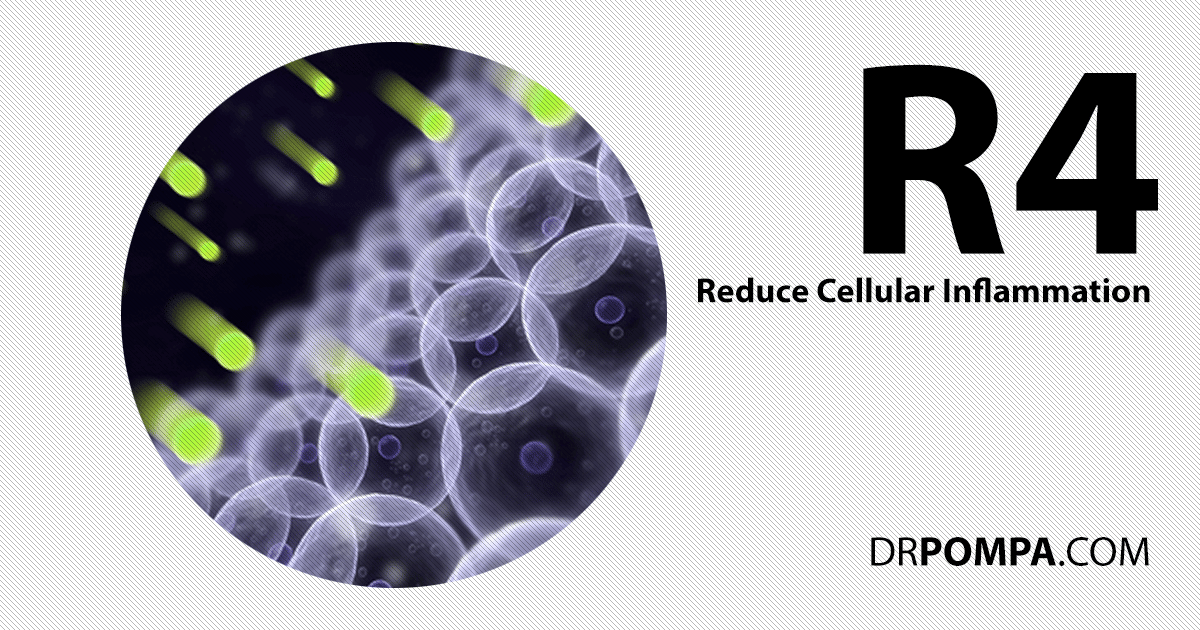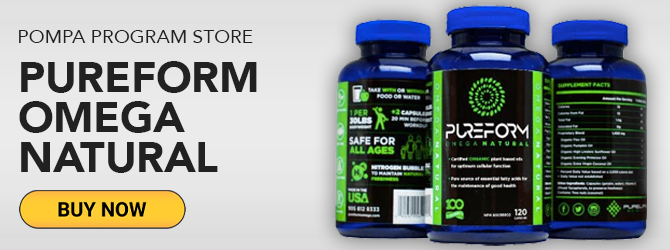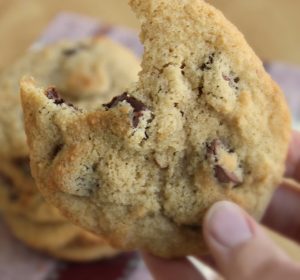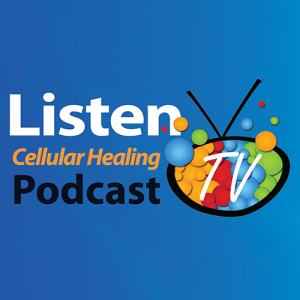R4 – Reducing Cellular Inflammation
Chronic inflammation is often referred to as the “silent killer” because it persists for years without presenting any noticeable symptoms. During this time, it slowly damages the body's tissues and organs, setting the stage for various chronic diseases.
Chronic cellular inflammation has been linked to a wide range of health problems, including obesity, heart disease, autoimmune disorders, and even mental health issues. This is because inflammation affects every system in our body and disrupts its normal functioning.1
Cellular inflammation is the underlying cause behind most chronic diseases.
When inflammation occurs in the gut, it can lead to conditions like leaky gut syndrome and irritable bowel syndrome (IBS). When it happens in the heart, it can contribute to the development of atherosclerosis and increase the risk of heart attacks and strokes. When it affects our brain, it can lead to cognitive decline and mood disorders such as depression.2 3
Toxins Cause Cellular Inflammation
When toxins enter the body, they trigger an inflammatory response in cells. This process is a natural defense mechanism that helps to eliminate harmful substances and repair damaged tissues. During inflammation, immune cells release cytokines, which are signaling molecules that help coordinate the body's response to injury or infection. However, if toxins continue to be present in the body, this inflammatory response can become chronic.4
One way that toxins cause cellular inflammation is by disrupting the balance of oxidative stress. Oxidative stress occurs when there is an imbalance between the production of reactive oxygen species (ROS) and the body's ability to detoxify them. ROS are highly reactive molecules that damage cells, leading to inflammation.5
In addition to promoting oxidative stress, toxins also directly damage cellular membranes. For example, heavy metals like lead and mercury bind to proteins and enzymes in the body, interfering with their normal function. This disruption of cellular processes triggers an inflammatory response as the body tries to repair the damage caused by the toxins.6
Read more about how toxins wreak havoc on the cellular membrane in R2 – Regenerating The Cellular Membrane.
Heavy metals have been shown to induce chronic inflammation in various parts of the body. One example is their effect on mitochondrial membranes. When heavy metals enter the body, they accumulate in the mitochondria and disrupt their function, leading to inflammation.7
Read more about optimizing mitochondria function in R3 – Restoring Cellular Energy.
Toxins also affect the gut microbiome, which is the collection of microorganisms that reside in our digestive system. The gut microbiome plays an important role in regulating the immune system and maintaining a healthy balance between pro-inflammatory and anti-inflammatory responses. Exposure to toxins disrupt this delicate balance and lead to chronic inflammation.8
Read more about toxins in R1 – Removing The Source Of Toxins.
When ATP Production Goes Down, Inflammation Goes Up
Dr. Martin Pall is a professor of biochemistry and basic medical sciences at Washington State University. He has extensively researched the effects of electromagnetic fields (EMFs) on human health and explains how EMFs can cause harm to our bodies.
Pall's research revolves around the concept of oxidative stress. EMFs and other toxins have been found to increase oxidative stress, leading to a chain reaction of events that ultimately results in chronic inflammation.9
According to Pall, one of the key components in this process is adenosine triphosphate (ATP), which is responsible for providing energy to our cells. When exposed to EMFs or other toxins, the production of ATP is significantly reduced, thus leading to a drop in energy levels within the body.
This decrease in ATP not only affects our physical energy but also impacts various biochemical processes that rely on ATP. One such process is the production of nitric oxide (NO), which plays a crucial role in regulating blood flow and inflammation. When there is a decline in ATP, the body's ability to produce NO is compromised, leading to an increase in inflammatory reactions.
Furthermore, reduced ATP production leads to an upregulation of certain enzymes that generate peroxynitrite (ONOO), a potent oxidant and pro-inflammatory molecule. This forms the basis of the “NO/ONOO cycle,” which dictates that chronic conditions such as fibromyalgia, multiple chemical sensitivity, and chronic fatigue syndrome are caused by this cycle.10

Consumption Of Bad Fats Trigger Cellular Inflammation
Bad fats, specifically rancid omega-6 fatty acids, are one of the main causes of cellular inflammation in the body. Unlike good fats such as omega-6 fatty acids from whole, unprocessed foods and omega-3 fatty acids which are essential for proper body functioning, bad fats cause damage to the cells in our body.11
For more information on omega-6 and omega-3 fatty acids, go back to R2 – Regenerating The Cellular Membrane.
Glucose And Insulin Spikes Cause Cellular Inflammation
Glucose and insulin are two important components in our bodies that play a crucial role in our metabolism. Glucose, also known as blood sugar, is the main source of energy for our cells. It comes from the food we eat and is transported through our bloodstream to different parts of our body.12
Insulin, on the other hand, is a hormone produced by the pancreas that helps regulate the levels of glucose in our blood. It acts as a key to unlock the cells and allow them to absorb glucose from our bloodstream, thus keeping our blood sugar levels in check.13
However, when we consume foods high in sugar or carbohydrates, it causes an excessive amount of glucose to enter our bloodstream. This leads to a spike in blood sugar levels, and in turn, the pancreas produces more insulin to help bring it down.14
These constant spikes in glucose and insulin lead to inflammation in our cells. This is because high levels of both glucose and insulin causes an increase in oxidative stress, which damages our cells and tissues. This triggers an immune response, leading to cellular inflammation.15
Cellular inflammation not only affects our body's ability to absorb glucose and utilize it for energy but also has a negative impact on other bodily functions. To avoid these potential health risks, it is important to maintain a balanced and healthy diet like my Cellular Healing Diet.
Fasting To Reduce Cellular Inflammation
Fasting has been found to reduce inflammation by impacting various cellular pathways. For example, it activates autophagy which is a process where damaged or old cells are broken down and recycled. This helps to remove inflammatory cells and promote the growth of new, healthy cells.16
Additionally, fasting also decreases levels of pro-inflammatory cytokines, a signaling molecule that promotes inflammation. This is due to the fact that when we fast, our bodies switch from using glucose as its main source of energy to using ketones, which have been shown to have anti-inflammatory properties.17
Perhaps the most significant way in which fasting reduces cellular inflammation is through its impact on gut health. Fasting allows the gut to rest and repair, helping to rebalance the microbiome and reduce inflammation.18
In addition to its ability to directly reduce inflammation, fasting also promotes overall health and wellness which indirectly impact cellular inflammation. For example, it can help with weight loss and improve insulin sensitivity, both of which have been linked to lower levels of inflammation in the body.19
Furthermore, fasting has been shown to improve immune function, which also plays a role in reducing chronic inflammation. When our immune system is functioning properly, it can identify and eliminate any harmful pathogens that are causing inflammation.20
Exercise Reduces Cellular Inflammation
Exercise plays a crucial role in reducing cellular inflammation. Physical activity releases endorphins, which not only boost our mood but also have anti-inflammatory effects on the body. Regular exercise also helps to improve circulation and strengthen the immune system, both of which are essential in reducing inflammation. Additionally, exercise can help to maintain a healthy weight, which is important as obesity is linked to increased inflammation in the body.21
Exercise has positive effects on mental health and can reduce stress levels. Stress has been shown to increase inflammatory markers in the body, so finding ways to manage and reduce stress through exercise has a significant impact on overall inflammation levels. Furthermore, regular exercise can also improve sleep quality, which is crucial for the body to repair and regenerate properly.22

Reducing Cellular Inflammation By Reducing Stress
Another important factor in reducing cellular inflammation is managing stress. Chronic stress has been linked to increased levels of inflammation in the body, so finding healthy coping mechanisms and practicing relaxation techniques can help keep inflammation at bay.23
R4 – Reducing Cellular Inflammation
Cellular inflammation is a major contributor to autoimmune conditions, hormonal imbalances, and weight gain. This can manifest in various forms such as joint pain, fatigue, skin disorders, digestive issues, depression, and so on. We must reduce cellular inflammation so we can get to the core cause of these issues.
After R4 – Reducing Cellular Inflammation, R3 – Restoring Cellular Energy, R2 – Regenerating The Cellular Membrane, and R1 – Removing The Source Of Toxins, it’s time to move onto the next step.
R5 – Reestablishing Methylation
References
1 Pahwa R, Goyal A, Jialal I. Chronic Inflammation. [Updated 2023 Aug 7]. In: StatPearls [Internet]. Treasure Island (FL): StatPearls Publishing; 2023 Jan-. Available from: https://www.ncbi.nlm.nih.gov/books/NBK493173/
2 Ng QX, Soh AYS, Loke W, Lim DY, Yeo WS. The role of inflammation in irritable bowel syndrome (IBS). J Inflamm Res. 2018 Sep 21;11:345-349. doi: 10.2147/JIR.S174982. PMID: 30288077; PMCID: PMC6159811.
3 Sartori AC, Vance DE, Slater LZ, Crowe M. The impact of inflammation on cognitive function in older adults: implications for healthcare practice and research. J Neurosci Nurs. 2012 Aug;44(4):206-17. doi: 10.1097/JNN.0b013e3182527690. PMID: 22743812; PMCID: PMC3390758.
4 Kany S, Vollrath JT, Relja B. Cytokines in Inflammatory Disease. Int J Mol Sci. 2019 Nov 28;20(23):6008. doi: 10.3390/ijms20236008. PMID: 31795299; PMCID: PMC6929211.
5 Zuo L, Prather ER, Stetskiv M, Garrison DE, Meade JR, Peace TI, Zhou T. Inflammaging and Oxidative Stress in Human Diseases: From Molecular Mechanisms to Novel Treatments. Int J Mol Sci. 2019 Sep 10;20(18):4472. doi: 10.3390/ijms20184472. PMID: 31510091; PMCID: PMC6769561.
6 Lahiani A, Yavin E, Lazarovici P. The Molecular Basis of Toxins' Interactions with Intracellular Signaling via Discrete Portals. Toxins (Basel). 2017 Mar 16;9(3):107. doi: 10.3390/toxins9030107. PMID: 28300784; PMCID: PMC5371862.
7 Balali-Mood M, Naseri K, Tahergorabi Z, Khazdair MR, Sadeghi M. Toxic Mechanisms of Five Heavy Metals: Mercury, Lead, Chromium, Cadmium, and Arsenic. Front Pharmacol. 2021 Apr 13;12:643972. doi: 10.3389/fphar.2021.643972. PMID: 33927623; PMCID: PMC8078867.
8 Al Bander Z, Nitert MD, Mousa A, Naderpoor N. The Gut Microbiota and Inflammation: An Overview. Int J Environ Res Public Health. 2020 Oct 19;17(20):7618. doi: 10.3390/ijerph17207618. PMID: 33086688; PMCID: PMC7589951.
9 Rosado MM, Simkó M, Mattsson MO, Pioli C. Immune-Modulating Perspectives for Low Frequency Electromagnetic Fields in Innate Immunity. Front Public Health. 2018 Mar 26;6:85. doi: 10.3389/fpubh.2018.00085. PMID: 29632855; PMCID: PMC5879099.
10 Pall ML. Electromagnetic fields act via activation of voltage-gated calcium channels to produce beneficial or adverse effects. J Cell Mol Med. 2013 Aug;17(8):958-65. doi: 10.1111/jcmm.12088. Epub 2013 Jun 26. PMID: 23802593; PMCID: PMC3780531.
11 DiNicolantonio JJ, O'Keefe J. The Importance of Maintaining a Low Omega-6/Omega-3 Ratio for Reducing the Risk of Autoimmune Diseases, Asthma, and Allergies. Mo Med. 2021 Sep-Oct;118(5):453-459. PMID: 34658440; PMCID: PMC8504498.
12 Norton L, Shannon C, Gastaldelli A, DeFronzo RA. Insulin: The master regulator of glucose metabolism. Metabolism. 2022 Apr;129:155142. doi: 10.1016/j.metabol.2022.155142. Epub 2022 Jan 20. PMID: 35066003.
13 Petersen MC, Shulman GI. Mechanisms of Insulin Action and Insulin Resistance. Physiol Rev. 2018 Oct 1;98(4):2133-2223. doi: 10.1152/physrev.00063.2017. PMID: 30067154; PMCID: PMC6170977.
14 Rahman MS, Hossain KS, Das S, Kundu S, Adegoke EO, Rahman MA, Hannan MA, Uddin MJ, Pang MG. Role of Insulin in Health and Disease: An Update. Int J Mol Sci. 2021 Jun 15;22(12):6403. doi: 10.3390/ijms22126403. PMID: 34203830; PMCID: PMC8232639.
15 Ma X, Nan F, Liang H, Shu P, Fan X, Song X, Hou Y, Zhang D. Excessive intake of sugar: An accomplice of inflammation. Front Immunol. 2022 Aug 31;13:988481. doi: 10.3389/fimmu.2022.988481. PMID: 36119103; PMCID: PMC9471313.
16 Alirezaei M, Kemball CC, Flynn CT, Wood MR, Whitton JL, Kiosses WB. Short-term fasting induces profound neuronal autophagy. Autophagy. 2010 Aug;6(6):702-10. doi: 10.4161/auto.6.6.12376. Epub 2010 Aug 14. PMID: 20534972; PMCID: PMC3106288.
17 Zhou RH, Wang Q, Hu XM, Liu M, Zhang AR. The influence of fasting and caloric restriction on inflammation levels in humans: A protocol for systematic review and meta analysis. Medicine (Baltimore). 2021 Apr 16;100(15):e25509. doi: 10.1097/MD.0000000000025509. PMID: 33847668; PMCID: PMC8052001.
18 Larrick JW, Mendelsohn AR, Larrick JW. Beneficial Gut Microbiome Remodeled During Intermittent Fasting in Humans. Rejuvenation Res. 2021 Jun;24(3):234-237. doi: 10.1089/rej.2021.0025. PMID: 34039011.
19 Vasim I, Majeed CN, DeBoer MD. Intermittent Fasting and Metabolic Health. Nutrients. 2022 Jan 31;14(3):631. doi: 10.3390/nu14030631. PMID: 35276989; PMCID: PMC8839325.
20 Qian J, Fang Y, Yuan N, Gao X, Lv Y, Zhao C, Zhang S, Li Q, Li L, Xu L, Wei W, Wang J. Innate immune remodeling by short-term intensive fasting. Aging Cell. 2021 Nov;20(11):e13507. doi: 10.1111/acel.13507. Epub 2021 Oct 27. PMID: 34705313; PMCID: PMC8590100.
21 Scheffer DDL, Latini A. Exercise-induced immune system response: Anti-inflammatory status on peripheral and central organs. Biochim Biophys Acta Mol Basis Dis. 2020 Oct 1;1866(10):165823. doi: 10.1016/j.bbadis.2020.165823. Epub 2020 Apr 29. PMID: 32360589; PMCID: PMC7188661.
22 Banno M, Harada Y, Taniguchi M, Tobita R, Tsujimoto H, Tsujimoto Y, Kataoka Y, Noda A. Exercise can improve sleep quality: a systematic review and meta-analysis. PeerJ. 2018 Jul 11;6:e5172. doi: 10.7717/peerj.5172. PMID: 30018855; PMCID: PMC6045928.
23 Rohleder N. Stress and inflammation – The need to address the gap in the transition between acute and chronic stress effects. Psychoneuroendocrinology. 2019 Jul;105:164-171. doi: 10.1016/j.psyneuen.2019.02.021. Epub 2019 Feb 20. PMID: 30826163.











